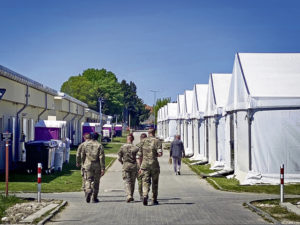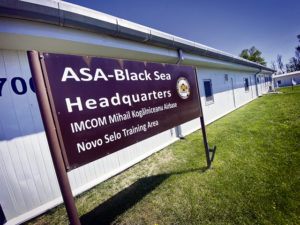
MIHAIL KOGALNICEANU AIR BASE, ROMANIA — Hundreds of American and international military paratroopers jumping from a half-dozen cargo aircraft soaring over Romania, May 11, culminated weeks of U.S. Army Garrison Rheinland-Pfalz continuous support to one of the Army’s premier exercises.
The garrison’s participation in DEFENDER-Europe 21 via its sites in Romania and Bulgaria, known as Area Support Activity-Black Sea, is a multipronged, ongoing effort staging American and international Soldiers and equipment for success. About 1,000 American Soldiers and Airmen, and Dutch, Polish, and German soldiers, called “MK” home for about 10 days. Weapons, ammunition, vehicles, and more are stored in dozens of facilities across the footprint, while the people live in 30 barracks and 22 newly erected tents.
“We’re agile and responsive enough that we can continue to focus on garrison operations while supporting this massive exercise and taking care of the hundreds of warfighters training during DEFENDER-Europe 21,” said Dave Keller, MK director of operations, who added this multitasking capacity is in the site’s wheelhouse. “Operationally, we’ve been able to showcase the garrison’s vital role in supporting the warfighter, and that’s exciting.”
Much of the garrison’s effort in Romania culminated May 10 with a ’joint forcible entry’ conducted on Boboc Air Base, Romania, with 6 Polish Airborne Brigade, 82nd Airborne Division, German/Dutch 11 Air Assault Brigade, and Romanian 495th Parachute Battalion. The Boboc jump was part of three near-simultaneous airborne operations done by multiple NATO allied nations supporting Swift Response 21, a military crisis response training event for multinational airborne forces, and another facet of DEFENDER-Europe 21.

Meanwhile, at the garrison site in Bulgaria, efforts continue in an austere environment. The Novo Selo Training Area comprises about 56 square miles of training space used by the U.S. and NATO for tank training and much more. More than 1,000 people have bulked up the site’s population, though much of their work for the exercise starts later.
James Adamski is the deputy garrison manager for Novo Selo. He said it was a pleasure to play a key role in the support. “We focus on a very high degree of readiness to support all reception, staging, and onward movement of participants in the exercise. I’m very proud of our team here.”
Sgt. Christopher Stocum is the IMCOM-E lead for Better Opportunities for Single Soldiers, but is deployed to help the MWR team. He said his BOSS experience and life as a young Solider helps him focus on his fellow GIs as people.
“Soldiers are more than just a number. It’s important to give people options and take care of them,” said Stocum, who highlighted a recent cornhole tournament drawing more than 40 people. “Taking care of them like people is number one. Soldiers with high morale are going to work harder than those without.”
Tommy R. Mize, Director, Installation Management Command Directorate-Europe, said providing exercise support for Defender 21 is a one of the strengths of the IMCOM-E Team.
“Our garrisons enable units in Europe to focus on operations, training, and deployments,” he said. “U.S. Army Garrison Rheinland-Pfalz and ASA-Black Sea’s support to this incredible exercise is another example of how we are fully engaged in providing world-class support for America’s premier fighting force.”
Exercise support is shared with the garrison, the Romanian hosts, contractors, and Area Support Group-Black Sea, which oversees the two sites plus another in Greece, and directs the sustainment portion of the troops’ visit in Romania.
Col. Andrew Conant, Area Support Group-Black Sea commander, said integration, cooperation, and communication between his team and the garrison has been critical to ensuring successful life support to rotational forces and exercise participants in Romania and Bulgaria.
“I am continuously impressed with the professionalism and one team approach between the ASG and ASA,” he said. “Our combined approach in serving the exercise audience has resulted in the successful movement, life support, and sustainment of 2,000 personnel at MK alone.”
Conant also highlighted the capability of the ’Mayor Cell,’ an integrated team of three IMCOM-E staff members and four Soldiers joined at the hip with the Area Support Group-Black Sea staff.
“The integrated Mayor Cell has proven to be instrumental in the execution of command and control, communication, and reporting as a collective team,” he said. “By integrating our staffs, establishing and engaging in frequent communications with our customers, we can eliminate single points of failure or friction.”
“Personally, this experience has been a highlight in my career, and I am continuously impressed with the professionalism and one team approach between the ASG and ASA,” he added.
ASA-Black Sea Garrison Commander Lt. Col. Jeremy McHugh said while there have been challenges to overcome, the team here has done a “magnificent” job ensuring the mission is met along all lines of effort while continuing to sustain enduring efforts to those continuously deployed here, including other Army mission and those with NATO.
“This is a truly a team effort that shows the important role Army garrisons play in DEFENDER-Europe 21,” McHugh said. “Our integration with ASG to ensure seamless garrison support has been one of the shining gems of this experience. It works, and it works well. We’re excited to continue to support our Soldiers and partner nations in a way that best enables them to lean forward on Defender 21 and train the way they will fight.”


